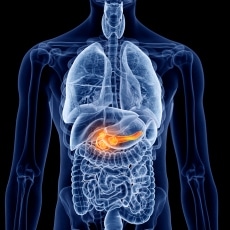
Pancreatic Cancer

Summary
The pancreas is a gland behind your stomach and in front of your spine. It produces the juices that help break down food and the hormones that help control blood sugar levels. Pancreatic cancer usually begins in the cells that produce the juices. Some risk factors for developing pancreatic cancer include:
- Smoking
- Long-term diabetes
- Chronic pancreatitis
- Certain hereditary disorders
Pancreatic cancer is hard to catch early. It doesn’t cause symptoms right away. When you do get symptoms, they are often vague or you may not notice them. They include yellowing of the skin and eyes, pain in the abdomen and back, weight loss and fatigue. Also, because the pancreas is hidden behind other organs, health care providers cannot see or feel the tumors during routine exams. Doctors use a physical exam, blood tests, imaging tests, and a biopsy to diagnose it.
Because it is often found late and it spreads quickly, pancreatic cancer can be hard to treat. Possible treatments include surgery, radiation, chemotherapy, and targeted therapy. Targeted therapy uses drugs or other substances that attack specific cancer cells with less harm to normal cells.
NIH: National Cancer Institute
Source: MedlinePlus, National Library of Medicine.
MedlinePlus brings together authoritative health information from the National Library of Medicine (NLM), the National Institutes of Health (NIH), and other government agencies and health-related organizations.
General Information about Pancreatic Cancer
National Cancer Institute
Rare Tumor of Pancreas
Genetic and Rare Diseases Information Center
What Is Pancreatic Cancer?
American Cancer Society
Abdominal exploration - series
Medical Encyclopedia
Amylase Test
National Library of Medicine
CA 19-9 Blood Test (Pancreatic Cancer)
National Library of Medicine
Can Pancreatic Cancer Be Found Early?
American Cancer Society
ERCP (Endoscopic Retrograde Cholangiopancreatography)
National Institute of Diabetes and Digestive and Kidney Diseases
Glucagon Blood Test
National Library of Medicine
Stage and Grade of Pancreatic Cancer
Johns Hopkins University, Department of Pathology
Stages of Pancreatic Cancer
National Cancer Institute
Stages of Pancreatic Neuroendocrine Tumors
National Cancer Institute
Tests for Pancreatic Cancer
American Cancer Society
Tumor Marker Tests
National Library of Medicine
Acupuncture for Pancreatic Cancer Patients
Pancreatic Cancer Action Network
Drugs Approved for Pancreatic Cancer
National Cancer Institute
Surgery for Pancreatic Cancer
American Cancer Society
Surgical Treatment
Johns Hopkins University, Department of Pathology
Treatment Option Overview (Pancreatic Cancer)
National Cancer Institute
Treatment Option Overview for Pancreatic Neuroendocrine Tumors (Islet Cell Tumors)
National Cancer Institute
Listen to our
latest Podcast!









